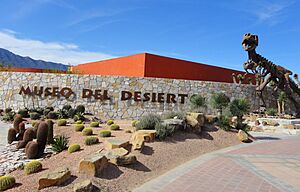Desert Museum (Mexico) facts for kids
The Desert Museum (Spanish: Museo del Desierto) is an exciting museum located in Saltillo, Coahuila, Mexico. It teaches people about the desert and why it's important to protect nature. A famous architect named Francisco López Guerra designed the museum, and it first opened its doors on November 25, 1999. This museum has a fantastic collection of ancient fossils, desert plants, and animals that live in the Mexican desert.
Contents
History of the Desert Museum
The Desert Museum officially opened on November 25, 1999. The president at that time, Ernesto Zedillo, and the leaders of the Amigos del Desierto de Coahuila foundation were there for the opening. The main goal of the museum was to help people understand and appreciate nature. It shows how life has changed over millions of years in an exciting and interactive way. The idea for the museum started in the 1990s. This was when many important discoveries were made in the region about its geology (how the Earth is made), anthropology (human history), palaeontology (fossils), and biology (living things).
Exploring the Museum's Pavilions
The Desert Museum is divided into four main sections, called pavilions, each with a different and interesting theme.
The Desert and Its Ancient Past
Because of things like wind and water shaping the land, it's easier to find fossils in the Mexican deserts. These fossils help us learn a lot about ancient life forms. This pavilion shows how deserts first formed. You can also see the rich minerals found here, especially coal, which is a very important resource in this area. The museum also features amazing dinosaurs that once lived in this region. These include Isauria, Sabinosaurio, and Quetzalcoatlus. There's even a huge Tyrannosaurus rex skeleton that is 17 meters (about 56 feet) long and five meters (about 16 feet) tall! You can also enjoy interactive displays about the newest fossil discoveries in the area.
People and the Desert: A Meeting Place
This pavilion mainly shows how the ancient nomadic people lived in this region. Nomads were groups of people who moved from place to place. You can see amazing petroglyphs (drawings carved into rock) and rupestrian paintings (paintings on rock walls). These artworks are very special to this area and tell stories from long ago.
Evolution and Life's Diversity
This particular pavilion opened on August 4, 2005. It shows how life has changed over the last 12,000 years. During this time, many different kinds of animals lived in this region. You can see traces of huge mammoths, fierce saber-toothed cats, giant short-faced bears, and elephant-like gomphotheres. It's a journey through time to see how life evolved!
The Laboratory of Life
This interactive pavilion takes you back 70 million years! It shows a huge variety of animals through a special biodome. A biodome is like a mini-ecosystem where plants and animals live together. The museum also has a herpetology laboratory. This is where scientists work with the museum's reptiles, like snakes and lizards, to study and care for them.
See also
 In Spanish: Museo del Desierto para niños
In Spanish: Museo del Desierto para niños


